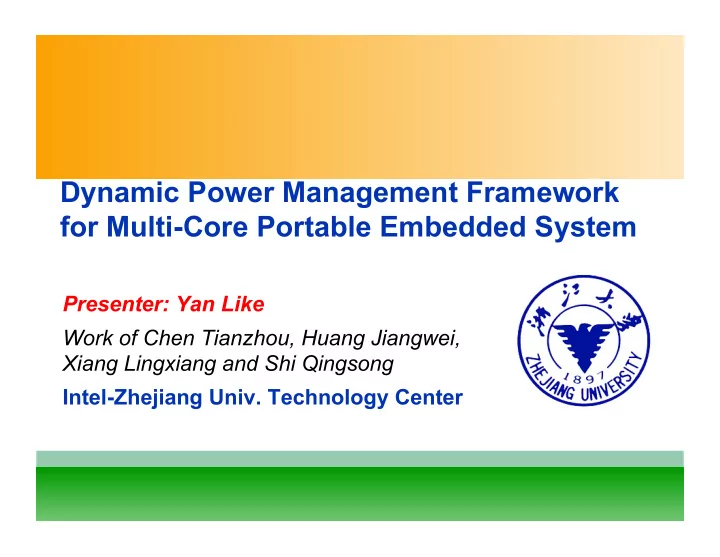

Dynamic Power Management Framework for Multi-Core Portable Embedded System � Presenter: Yan Like Work of Chen Tianzhou, Huang Jiangwei, Xiang Lingxiang and Shi Qingsong Intel-Zhejiang Univ. Technology Center
Agenda 1. INTRODUCTION Power and Multi-core Multi-core and Embedded system 2. DPM FRAMEWORK Profiler Model Global Policy Layer 3. EXPERIMENT and RESULT 4. FUTURE WORKS
Power and Multi-core � Number of transistors on a chip doubles about every two years------ Moore's Law EV8 is 80 times bigger but provides only two to three times more single-threaded performance � the growth of power consumption and core size are multiplying, whereas Multi-core allows throughput increase while avoiding a significant the performance did not bring about a significant increase. increase in power The power dissipation and performance of four generations of Alpha microprocessor cores scaled to run at the same frequency
Multi-core for Embedded system � • Power continues to be the key factor whcih limits the performance in multi-core regime, especially in portable multi- core embedded system • Driven by battery. • Mobile Phone, PDA, UMPC, etc.. • The limited capacity of Battery. • The power resource is limited, so we have to pinch pennies power dissipation problem still exists in the new multi-core regime for Embedded system
Our Work � A dynamic power management framework • Combining with core-level and global scheduling heuristic management. • Tries to assign applications to the proper cores, at the same time the frequency and voltage of core could be adjusted according to the application behavior. • Provide a global policy, and offer a single core DVS algorithm. �
The DPM Framework � The Profiler is used to gathering the performance information of the system Global Policy layer makes the global power management decision and issue the global commands to the Local Translate the Global component management � commands into a set of the local commands � The local processor power manager manages the physical core’s states. �
The Profiler � The Profiler is used to gathering the performance information of the system • Performance profiler • monitors the hardware layer • gathers the performance information from the hardwares • Idle profiler • gives the CPU usage and OS idle information to the DPM module by monitoring the idle thread of the OS �
Global Policy Layer �
Deadline test algorithm � DeadLineTest(P new , CurrentBuffer) Int DeadLine= 0; for( all processes in the buffer) DeadLine +=P i .WT- P i .RT; if(P new .DT-T current -DeadLine- P new .WT)>=0 return success; else return failed;
Processor throughput test algorithm � ThroughputTest(Pnew) Int BufferID=0; SortingBuffer(); For(All the buffers) Int RunTime= 0; Int BiggestDeadLine=Pnew.DT; For( all processes in the buffer) RunTime +=Pi.WT- Pi.RT; If(BiggestDeadLine< Pi.DT) BiggestDeadLine= Pi.DT; If(RunTime+ Pnew.DT+ Tcurrent< BiggestDeadLine) BufferID=currentBuffer; If(DeadLineTest(Pnew, BufferID)) Return; �
Experiment Setup � Platform • Use a cycle-accurate simulator on DELL INSPIRON 9400. • Modeling two cores and shared L2 cache based on Intel Duo Core Processor. • The power statistics are acquired from a power modeling methodology using PMU. • A DPM_DuoCore patch is added to Linux kernel 2.6.0.
Result � • 4 MPEG4 decoders on the platform. • Two single core adjusting strategies: IS and AS • (From “Brock, B. and K. Rajamani, Dynamic Power Management for Embedded Systems, in IEEE International SOC Conference. 2003”) • Result � Strategy � System Power (mw) � Normalized to Default � Default � 5749.6 � 100% � AS strategy saves more power than IS and Default IS � 4887.2 � 85% � AS � 4302.1 � 74.8% �
Future works � • More experiments is on going • More kinds of workloads • More homogeneous cores • Heterogeneous cores • Exploring an more power efficient scheduling algorithm for the processes in a same buffer under the deadline constraints • By grouping the different type of computing, so the hardware utilization could be improved… • By sequentially issue the same type of computing to burst the same operations of hardwares…
Thank you for your time! tzchen@zju.edu.cn hjw@zju.edu.cn
Recommend
More recommend